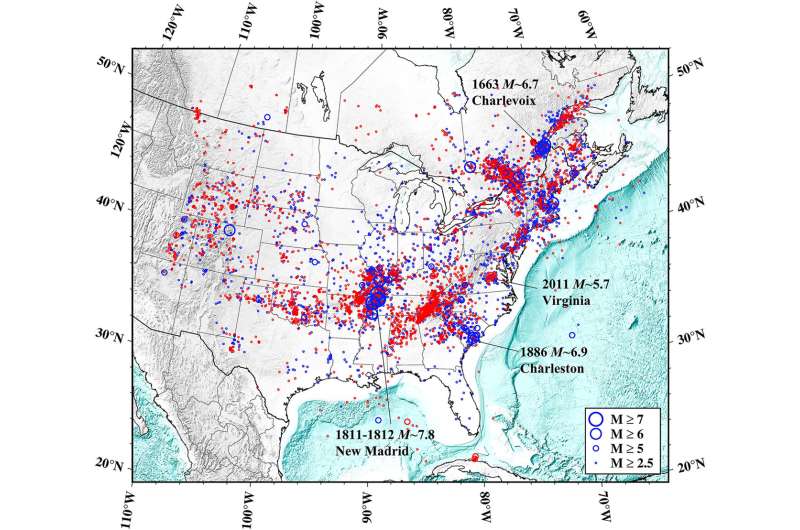This article has been reviewed according to Science X's editorial process and policies. Editors have highlighted the following attributes while ensuring the content's credibility:
fact-checked
peer-reviewed publication
trusted source
proofread
Some of today's earthquakes may be aftershocks from quakes in the 1800s

In the 1800s, some of the strongest earthquakes in recorded U.S. history struck North America's continental interior. Almost two centuries later, the central and eastern United States may still be experiencing aftershocks from those events, a study published in the Journal of Geophysical Research: Solid Earth finds.
When an earthquake strikes, smaller quakes known as aftershocks can continue to shake the area for days to years after the original earthquake occurred. These smaller quakes decrease over time and are part of the fault's readjustment process following the original quake. While aftershocks are smaller in magnitude than the main shock, they can still damage infrastructure and impede recovery from the original earthquake.
"Some scientists suppose that contemporary seismicity in parts of stable North America are aftershocks, and other scientists think it's mostly background seismicity," said Yuxuan Chen, a geoscientist at Wuhan University and lead author of the study. "We wanted to view this from another angle using a statistical method."
Regions near these historic earthquakes' epicenters are still seismically active today, so it's possible that some modern earthquakes could be long-lived aftershocks of past quakes. However, they could also be foreshocks that precede larger earthquakes or background seismicity, which is the normal amount of seismic activity for a given region.
According to the U.S. Geological Survey (USGS), there's no way to distinguish foreshocks from background seismicity until a larger earthquake strikes, but scientists can still discern aftershocks. Thus, identifying the cause of modern earthquakes is important for understanding these regions' future disaster risk, even if current seismic activity is causing little to no damage.
The team focused on three historic earthquake events estimated to range from magnitude 6.5–8.0: an earthquake near southeastern Quebec, Canada, in 1663; a trio of quakes near the Missouri-Kentucky border from 1811 to 1812; and an earthquake from Charleston, South Carolina, in 1886. These three events are the largest earthquakes in stable North America's recent history—and larger quakes trigger more aftershocks.
The stable continental interior of North America is located far from plate boundaries and has less tectonic activity than regions close to plate boundaries, such as North America's west coast. As a result, the three study areas don't encounter earthquakes often, raising even more questions about the origins of their modern seismicity.
To figure out if some of today's earthquakes are long-lived aftershocks, the team first needed to determine which modern quakes to focus their efforts on. Aftershocks cluster around the original earthquake's epicenter, so they included earthquakes within a 250-kilometer (155-mile) radius of the historic epicenters. They focused on earthquakes that were greater than or equal to a magnitude of 2.5 because anything smaller than that is difficult to reliably record.
The team applied a statistical approach called the nearest neighbor method to USGS earthquake data to determine whether recent earthquakes were likely to be aftershocks or unrelated background seismic activity. Aftershocks occur close to the original quake's epicenter and before the level of background seismicity has resumed, according to the USGS. Thus, scientists can use a region's background seismicity and an earthquake's location to link a quake back to a mainshock.
"You use the time, distance and the magnitude of event pairs, and try to find the link between two events—that's the idea," Chen said. "If the distance between a pair of earthquakes is closer than expected from background events, then one earthquake is likely the aftershock of the other."
Susan Hough, a geophysicist with the USGS who was not involved in the study, mentions that the distance between epicenters is only one piece of the puzzle.
"In some respects, the earthquakes look like aftershocks if you look at the spatial distribution, but earthquakes could be tightly clustered for a couple of reasons," Hough said. "One is that they're aftershocks, but also you could have a process of creep going on that's not part of an aftershock process. Exactly what their results mean is still open to question."
Looking at the spatial distribution, the study found that the 1663 aftershock sequence near southeastern Quebec, Canada, has ended and modern seismicity in the area is unrelated to the old quake. However, the other two historic events may still be triggering aftershocks centuries later.
Near the Missouri-Kentucky border, the researchers found that around 30% of all earthquakes from 1980 to 2016 were likely aftershocks from the major earthquakes that struck the area between 1811 and 1812. And in Charleston, South Carolina, the team found around 16% of modern-day quakes were likely aftershocks from the earthquake of 1886. Thus, modern seismicity in these regions is likely attributable to both aftershocks and background seismicity.
"It's kind of a mixture," Chen said.
For assessing a region's modern seismic risk, scientists monitor creep and background seismicity in addition to any aftershocks. The study found background seismicity to be the dominant cause of earthquakes in all three of the study regions, which could be a sign of continued strain accrual. Aftershock sequences weaken over time, but strain accrual can lead to larger earthquakes in the future. However, some faults can creep along without building up strain.
"To come up with a hazard assessment for the future, we really need to understand what happened 150 or 200 years ago," Hough said. "So bringing modern methods to bear on the problem is important."
More information: Yuxuan Chen et al, Long‐Lived Aftershocks in the New Madrid seismic Zone and the Rest of Stable North America, Journal of Geophysical Research: Solid Earth (2023). DOI: 10.1029/2023JB026482
Journal information: Journal of Geophysical Research
Provided by American Geophysical Union


















